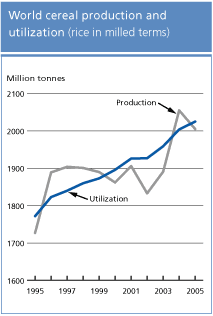Rome, Italy
December, 2005
HIGHLIGHTS
FAO latest forecast for the
2005 world cereal output has been raised considerably since the
September report to 2 005 million tonnes, 2.4 percent lower
than last year’s record crop. Cereal crops have been
satisfactory in most regions, except parts of Africa and South
America.
 Planting
of the 2006 cereal crop is underway in the main producing
regions under generally favourable conditions so far.
However, prospects are uncertain in Southern Africa and South
America. Planting
of the 2006 cereal crop is underway in the main producing
regions under generally favourable conditions so far.
However, prospects are uncertain in Southern Africa and South
America.
Global cereal utilization is
forecast to rise in 2005/06, with an expected increase in
food consumption leading to some gains in the average per capita
consumption in developing countries. By contrast, feed use of
cereals is expected to decline.
World cereal stocks are
forecast to decrease, mostly reflecting smaller coarse
grains inventory as a result of lower production this year.
Cereal trade is expected to
contract in 2005/06 following improved production in several
major importing countries, mainly in Asia.
International prices of
cereals are generally higher than a year ago. Export prices
have increased sharply in Argentina, reflecting reduced wheat
production, and in South Africa as a result of high regional
demand for maize.
World milk output is
expected to grow in 2005, but supplies from traditional
exporters remain tight. International trade prices have
stabilized at high levels supported by firm demand, particularly
in Asia and North Africa.
International prices of
oilseeds have weakened in recent months following a substantial
increase in production in 2004/05 (October/September), which
has resulted in record oilseed carryover stocks.
Global sugar production is
forecast to rise in 2005 but sustained demand in developing
countries will likely keep the global supply tight.
International sugar prices remain firm.
International banana prices
have increased reflecting the impact of adverse weather in Latin
America. In late November, the EU adopted a tariff-only
system for banana imports due to start in January 2006.
Any further extensive spread
of avian flu could seriously disrupt global poultry and feed
markets.
COMPLETE REPORT:
http://www.fao.org/documents/show_cdr.asp?url_file=/docrep/008/J6801e/J6801e00.htm
|